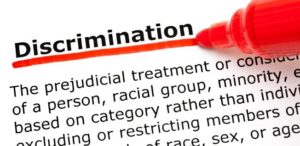 On July 19, 2017, the Louisiana State Bar Association’s Rules of Professional Conduct Committee began accepting written comments on the adoption of a new anti-discrimination standard of professional conduct. A subcommittee of the Rules Committee has proposed the addition of a new Louisiana Rule 8.4(h), that would provide as follows:
On July 19, 2017, the Louisiana State Bar Association’s Rules of Professional Conduct Committee began accepting written comments on the adoption of a new anti-discrimination standard of professional conduct. A subcommittee of the Rules Committee has proposed the addition of a new Louisiana Rule 8.4(h), that would provide as follows:
It is professional misconduct for a lawyer to: . . . (h) engage in conduct in connection with the practice of law that the lawyer knows or reasonably should know involves discrimination prohibited by law because of race, color, religion, age, gender, sexual orientation, national origin, marital status, or disability. This Rule does not prohibit legitimate advocacy when race, color, religion, age, gender, sexual orientation, national origin, marital status, or disability are issues, nor does it limit the ability of a lawyer to accept, decline or withdraw from a representation in accordance with Rule 1.16.
See LSBA Rules of Professonal Conduct, Rule 8.4 Subcommittee Report Executive Summary at p. 2 (Mar. 24, 2017); see also LSBA Rules of Professional Conduct Committee, Rule 8.4 Subcommittee Report (Mar. 24, 2017) (full report).
Should the Louisiana State Bar Association recommend, and should the Louisiana Supreme Court adopt, this or a similar standard of professional conduct? Well, it depends …..
Background: The 2016 Adoption of ABA Model Rule 8.4(g)
In 2016, the ABA amended Model Rule 8.4 to include a broad anti-discrimination and anti-harassment provision, and three revised comments. The amendment, which was sponsored by several ABA groups,1 added this new paragraph (g) to the black-letter of Rule 8.4:
It is professional misconduct for a lawyer to: . . . (g) engage in conduct that the lawyer knows or reasonably should know is harassment or discrimination on the basis of race, sex, religion, national origin, ethnicity, disability, age, sexual orientation, gender identity, marital status or socioeconomic status in conduct related to the practice of law. This paragraph does not limit the ability of a lawyer to accept, decline, or withdraw from a representation in accordance with Rule 1.16. This paragraph does not preclude legitimate advice or advocacy consistent with these rules.
See ABA Revised Resolution 109 (adopted Aug. 8, 2016). The three revised comments to Rule 8.4 provide as follows:
[3] Discrimination and harassment by lawyers in violation of paragraph (g) undermines confidence in the legal profession and the legal system. Such discrimination includes harmful verbal or physical conduct that manifests bias or prejudice towards others. Harassment includes sexual harassment and derogatory or demeaning verbal or physical conduct. Sexual harassment includes unwelcome sexual advances, requests for sexual favors, and other unwelcome verbal or physical conduct of a sexual nature. The substantive law of antidiscrimination and anti-harassment statutes and case law may guide application of paragraph (g).
[4] Conduct related to the practice of law includes representing clients; interacting with witnesses, coworkers, court personnel, lawyers and others while engaged in the practice of law; operating or managing a law firm or law practice; and participating in bar association, business or social activities in connection with the practice of law. Lawyers may engage in conduct undertaken to promote diversity and inclusion without violating this rule by, for example, implementing initiatives aimed at recruiting, hiring, retaining and advancing diverse employees or sponsoring diverse law student organizations.
[5] A trial judge’s finding that peremptory challenges were exercised on a discriminatory basis does not alone establish a violation of paragraph (g). A lawyer does not violate paragraph (g) by limiting the scope or subject matter of the lawyer’s practice or by limiting the lawyer’s practice to members
of underserved populations in accordance with these Rules and other law. A lawyer may charge and collect reasonable fees and expenses for a representation. Rule 1.5(a). Lawyers also should be mindful of their professional obligations under Rule 6.1 to provide legal services to those who are unable to pay, and their obligation under Rule 6.2 not to avoid appointments from a tribunal except for good cause. See Rule 6.2(a), (b) and (c). A lawyer’s representation of a client does not constitute an endorsement by the lawyer of the client’s views or activities. See Rule 1.2(b).
It is often difficult to have a rational discussion about anti-discrimination and anti-harassment rule making. Some fervently believe that such provisions are yet another example of political correctness run a muck. Others just as fervently believe that such provisions serve to promote inclusiveness and confidence in the legal profession.
Breadth of ABA Model Rule

Irrespective of viewpoint, every lawyer should be concerned about the breadth of the ABA’s model rule.
First, the rule broadly defines “harassment” to include any “derogatory or demeaning verbal conduct” by a lawyer relating to a person’s “race, sex, religion, national origin, ethnicity, disability, age, sexual orientation, gender identity, marital status or socioeconomic status.” Even words that are not “harmful” meet the definition of “harassment” if they are “derogatory or demeaning” and relate to a designated category of person.
Second, the rule subjects to discipline not only a lawyer who knowingly engages in harassment or discrimination, but also a lawyer who negligently utters a derogatory or demeaning comment. So, a lawyer who did not know that a comment was offensive will be disciplined if the lawyer should have known that it was. It will be interesting to see how the “objectively reasonable lawyer” will be constructed for purposes of making this determination.
Third, the rule subjects to discipline not only a lawyer who slings a “derogatory or demeaning comment” directly at another person, but also a lawyer who makes an abstract comment about general types or categories of people. Indeed, in revising comment 4, the ABA expressly deleted language that would have limited the definition of “harassment” to include only derogatory or demeaning conduct directed “towards a person who is, or is perceived to be, a member of one of the groups.”
Fourth, the rule subjects to discipline a lawyer who discriminates on the basis of “socioeconomic status.” What is that? UCLA Law Professor Eugene Volokh raises this (valid) concern:
That term isn’t defined in the proposed rule, but the one definition I’ve seen — interpreting a similar ban on socioeconomic-status discrimination in the Sentencing Guidelines — is “an individual’s status in society as determined by objective criteria such as education, income, and employment.” United States v. Lopez, 938 F.2d 1293, 1297 (D.C. Cir. 1991); see also United States v. Peltier, 505 F.3d 389, 393 & n.14 (5th Cir. 2007) (likewise treating wealth as an element of socioeconomic status); United States v. Graham, 946 F.2d 19, 21 (4th Cir. 1991) (same).
Eugene Volokh, Banning Lawyers from Discriminating Based on ‘Socioeconomic Status’ in Choosing Partners, Employees or Experts, The Volokh Conspiracy (Aug. 10, 2016). Volokh questions whether this rule will prohibit a law firm from preferring lawyers, nonlawyer assistants, and expert witnesses with degrees from high-status educational institutions. Id.
Permissible Discrimination Under the ABA Model Rule
Not all discriminatory conduct is verboten under this new model rule. The amended comments specifically permit “conduct”—which presumably includes both discrimination and harassment—if “undertaken to promote diversity and inclusion.” In addition, the comments note that a lawyer may discriminate on the basis of “socioeconomic status”—in direct violation of the black-letter provision—if the discrimination is intended to benefit “members of underserved populations.”
What Should Louisiana Do?
For starters, Louisiana should not adopt the ABA’s new standard. For all of the reasons discussed above, the ABA model rule is fraught with problems.
Moreover, Louisiana should not adopt the March 2017 proposal of the Rule 8.4 Subcommittee. Granted, the subcommittee’s proposal is less problematic than the new ABA model rule. For example, it does not brand any sort of “harassment” as misconduct, and thereby avoids the myriad problems associated with the ABA anti-harassment standard.
However, the subcommittee proposal still raises questions. It brands as “misconduct” purely negligent discrimination. It inexplicably incorporates some of the ABA’s protected classes (race, religion, age, gender, sexual orientation, national origin, marital status, and disability), but excludes others (ethnicity, gender identity, and socioeconomic status). What is it about gender identity, ethnicity, and socioeconomic status that are unworthy of protection?
In my view, Louisiana should adopt a simpler anti-discrimination standard that is directly tethered to anti-discrimination laws applicable to Louisiana lawyers. Such anti-discrimination laws would include those enacted by the federal government, the State of Louisiana, and local governments. Doing so would avoid the need for the LSBA to “keep up” with changing notions of what personal characteristics are worthy of class protection.2 Doing so would also avoid imposing discipline on innocent and merely negligent lawyers. Here is my proposed language:
It is professional misconduct for a lawyer to: . . . (h) engage in conduct in connection with the practice of law that the lawyer knows is unlawful discrimination prohibited by federal, state, or local law. This Rule does not prohibit legitimate advocacy when a protected personal characteristic is relevant to the representation, nor does it limit the ability of a lawyer to accept, decline or withdraw from a representation in accordance with Rule 1.16.
Let Your Voice be Heard
The comment period on this proposed anti-discrimination standard opened on July 19, 2017, and closes on September 16, 2017. To weigh in, email your thoughts to: “SUBJECT: Rule 8.4(g) Subcommittee Recommendation” c/o RLemmler@lsba.org. Be aware that the LSBA will consider all comments public and may publish them on its website.
- The amendment was sponsored by the ABA’s Standing Committee on Ethics and Professional Responsibility, the Section of Civil Rights and Social Justice, the Commission on Disability Rights, the Diversity & Inclusion 360 Commission, the Commission on Racial and Ethnic Diversity in the Profession, the Commission on Sexual Orientation and Gender Identity, and the Commission on Women in the Profession. See Lorelei Laird, Discrimination and Harassment Will be Legal Ethics Violations Under ABA Model Rule, ABA Journal (Aug. 8, 2016, 6:36 p.m.). ↵
- For example, my proposal would brand as “misconduct” unlawful conduct based on personal characteristics protected by federal law such as race, color, religion, national origin, age, sex, sexual orientation, gender idenity, pregnancy, citizenship, familial status, disability status, veteran status, and genetic information. ↵
